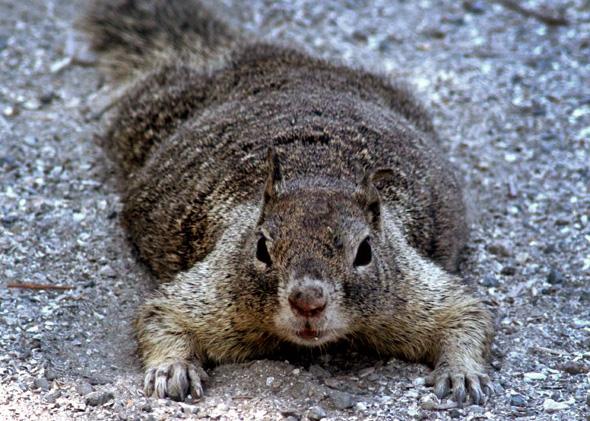When a family member catches you eating leftover Thanksgiving pie straight from the fridge, do you apologize with “Guess I’m hibernating”? Do you believe a biological imperative is urging you to consume pumpkin muffins until you’re the size of a mama grizzly, then burrow under a comforter and sleep until spring? Sorry. Humans aren’t hibernators—and if we were, it would look nothing like what you’re imagining.
For a start, there’d be no winter weight gain. Hibernators need to pack on pounds in the summer and fall; an animal that waited until the temperature dropped to start seeking extra calories would be in trouble. Hibernating bats build up fat during September and October and hibernate starting in November. Bears in Yellowstone plump up during the summer and early fall. Since winter is when food is scarcest, animals that are going to hibernate need to store as much fat as possible before the cold really sets in.
In fact, for at least some animals, hibernation has more to do with a shortage of food than with the weather. Bears that live in a zoo and have plenty of food available opt not to hibernate at all. If a grizzly or black bear could look at its calendar and see holiday parties with passed appetizers booked through the new year, it might never bother hunkering down in the first place.
Other animals hibernate even when it’s warm out and there’s food to eat. The dormouse Glis glis sometimes hits the snooze button and keeps hibernating well into summer, perhaps because being in its burrow keeps it safe from predators. (It unfortunately lives up to its common name, the edible dormouse.) Eastern long-eared bats do the same thing. The short-beaked echidna quits hibernating in the middle of winter so it can mate.

Photo courtesy mararie/Flickr
Whenever hibernation happens, serious hypothermia is a key part of it. Animals’ body temperatures may plummet to near the air temperature in their hideout (or “hibernaculum”). The mountain pygmy possum, a pocket-size marsupial in Australia, lets its body temperature fall to nearly 36 degrees Fahrenheit. Bears are the exception; their temperatures drop by only about 12 degrees Fahrenheit while they’re hibernating. Still, a loss of just 3 or 4 degrees in humans is considered a medical emergency.
Although they don’t do much in their chilly chambers, hibernating animals aren’t necessarily sleeping. Ground squirrels sleep only once every couple of weeks while hibernating, and they have to rouse themselves from hibernation to do so. A recent study led by Andrew Krystal at Duke University found that fat-tailed dwarf lemurs—the only primates known to hibernate—also sleep rarely. “Hibernation may, in fact, make you feel quite tired after you come out of it,” says Marina Blanco, another lemur researcher at Duke. On a cold weekday morning in winter, your fantasy about getting back under the covers until you’re good and refreshed is one that hibernating mammals might share.
Blanco speculates that if humans had evolved to hibernate, we’d do it more like the frigid lemur than the tepid bear, since the lemur is a closer relative. We’d stretch and warm up periodically, though; most hibernating animals thaw out once every few days or weeks. (This is when the ground squirrel and lemur seize their naps).
But warming up takes a lot of energy, and the whole point of hibernating is to slow an animal’s metabolism. To keep its body running on no fuel, an animal has to dial everything down: temperature, heart rate, breathing. Bears take a breath once every 45 seconds while hibernating (as opposed to every six to 10 seconds normally). The California ground squirrel’s heart rate drops to as little as one beat per minute. The male pygmy possum’s testes regress until spring. Grizzlies and black bears stop urinating and defecating entirely—so for half the year or more, the answer to “Does a bear shit in the woods?” is actually no.
That’s not to say hibernators are enjoying a lazy, carefree vacation. They can move around to get away from predators or to put their bodies in a sunny spot for rewarming. Female bears, the least lazy of all, give birth while they’re hibernating. Besides sustaining their own bodies through the winter, their stored fat has to provide enough energy to deliver and nurse multiple bear cubs.
A typical hibernating mammal loses about 40 percent of its body weight in the process. Another perk humans might envy, according to Blanco, is that hibernation seems tied to longevity. If we could hibernate, our bodies might age more slowly during that time. However, she adds, we’d have to find someplace to stash the extra fat beforehand. Our closest hibernating relative, the fat-tailed lemur, stores its provisions in its tail—but where would ours go? Maybe the answer will become clear after a few more helpings of sweet potatoes.
